Rose Tteokbokki (Creamy Korean Rice Cakes)
If you’ve ever wanted a comforting twist on tteokbokki, this creamy rosé tteokbokki recipe is the one to try. Chewy rice cakes are coated in a smooth gochujang cream sauce that’s mildly spicy, rich, and deeply satisfying. It’s the perfect blend of Korean street food flavors with a café-inspired touch, and it comes together in just 20 minutes.
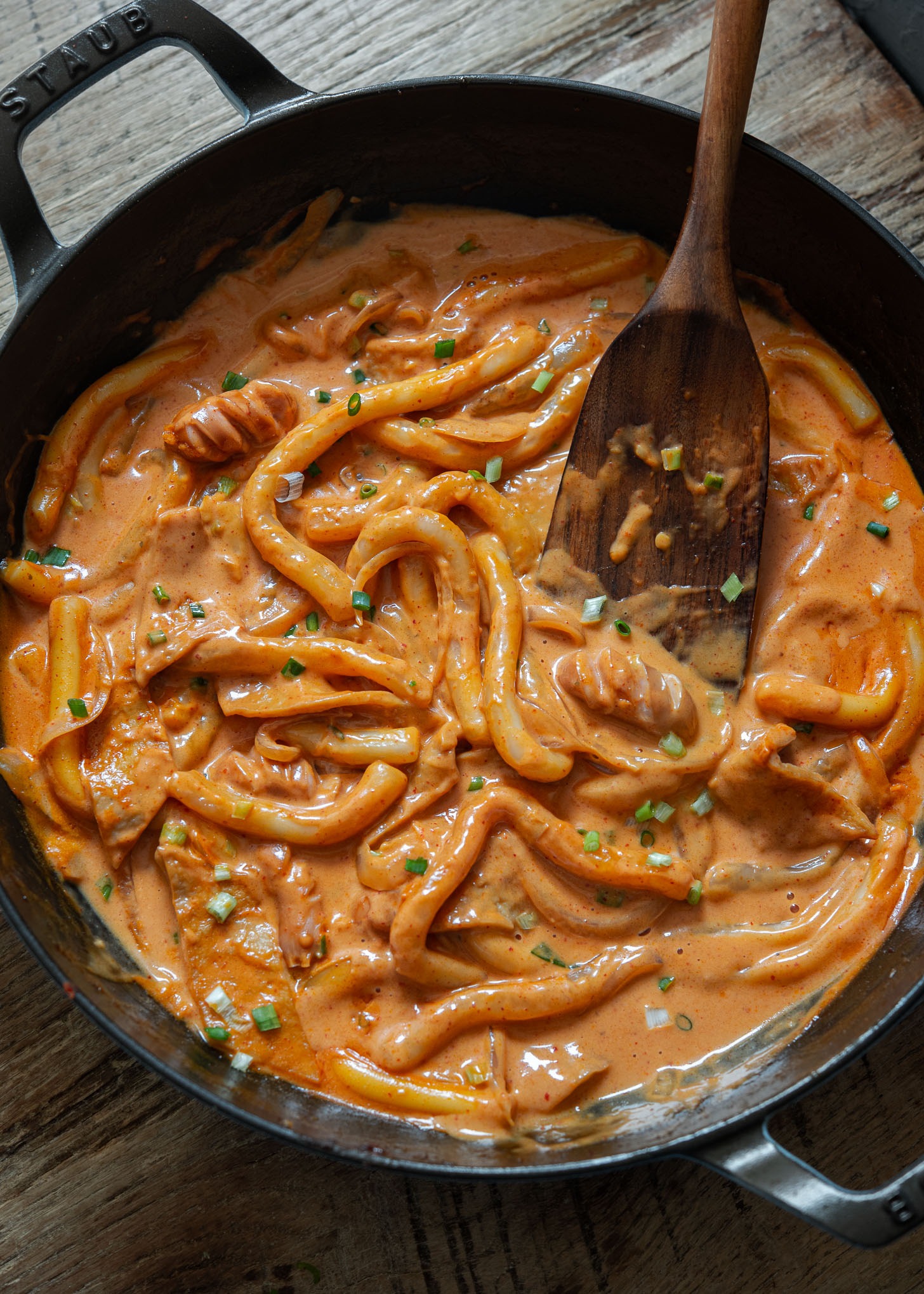
Living in Korea, I often spot rose tteokbokki(로제 떡볶이) on menus at cozy bunsik shops—the casual eateries where classic Korean tteokbokki is always a favorite alongside kimbap and ramyeon.
This version takes its cue from Italian rosé pasta sauce but trades the noodles for chewy Korean rice cakes and a touch of gochujang. The result is creamy with just enough heat—comforting, trendy, and one of the most popular Korean café foods today. It’s a dish that feels both familiar and totally new.
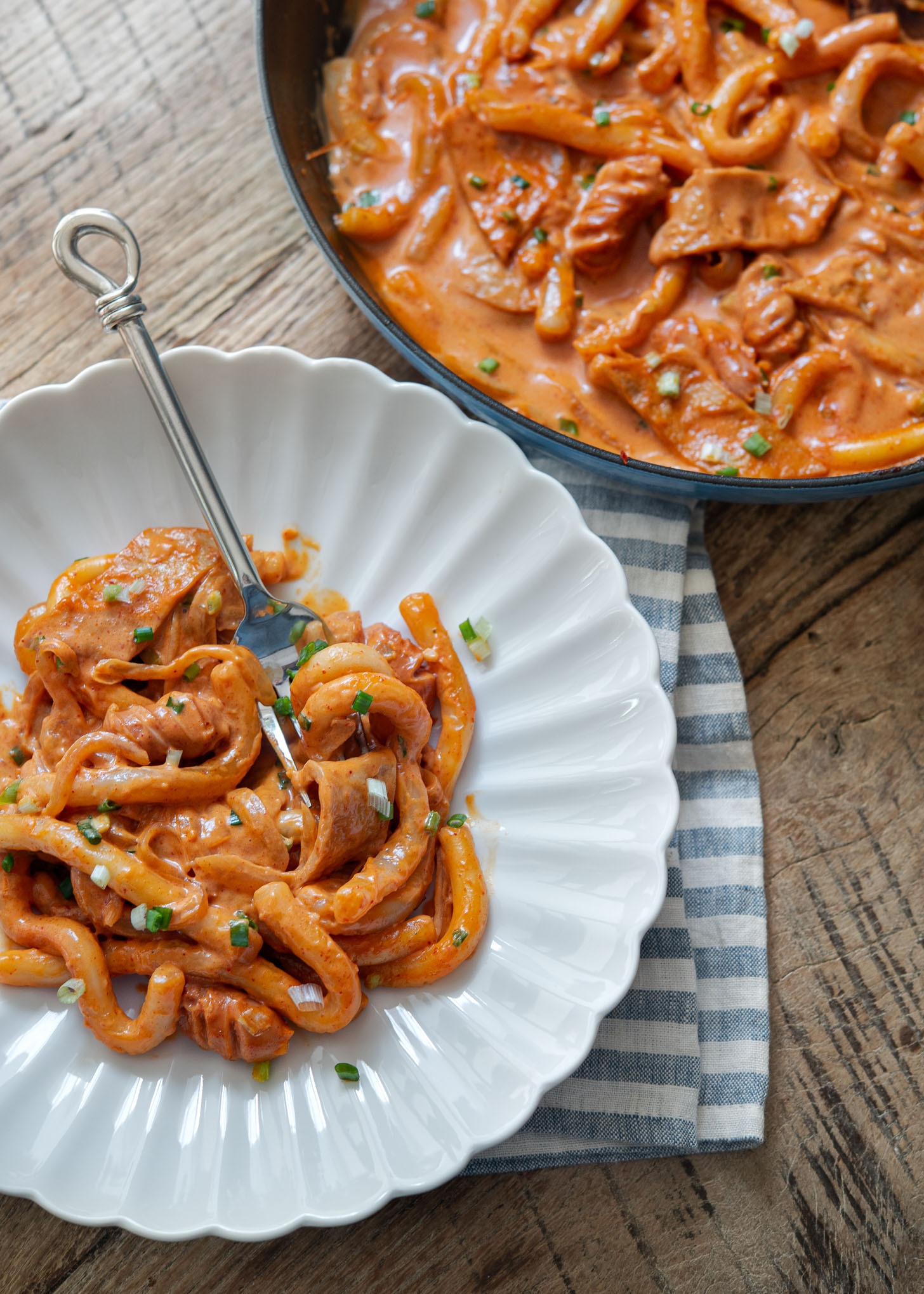
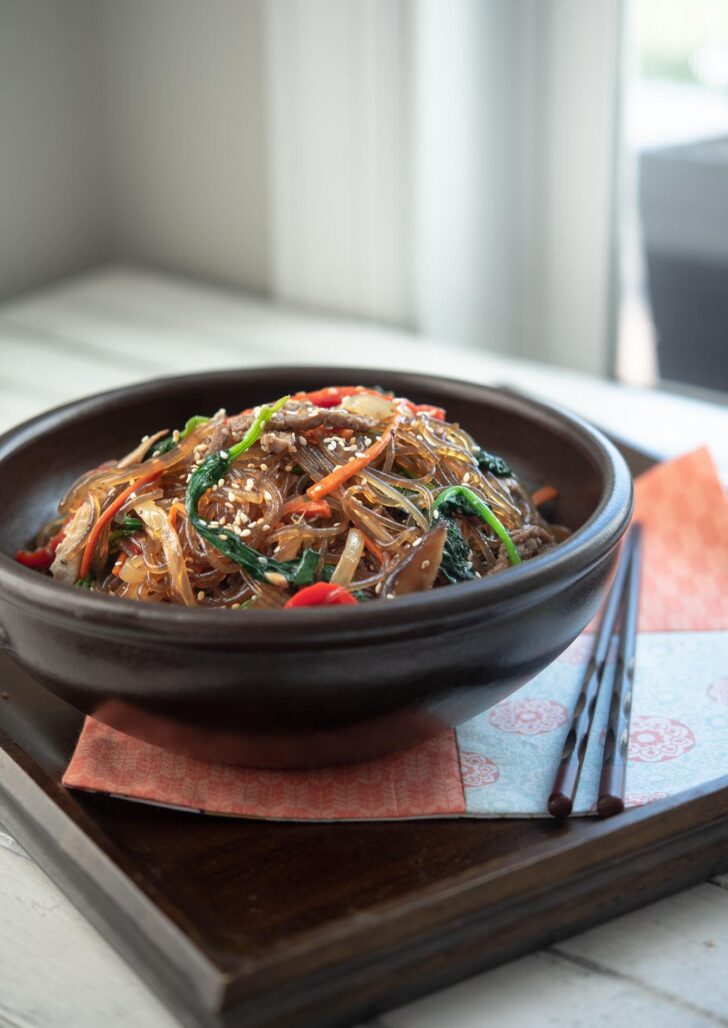
Get new recipes via email:
Why You’ll Love It
- Mildly spicy! Unlike classic spicy Korean rice cakes, this creamy tteokbokki balances comfort with a gentle heat
- Ready in under 20 minutes with simple, everyday ingredients for quick weeknight meal or snack.
- Easy to customize with sausage, fish cake, noodles, or cheese.
- A trendy Korean fusion dish that feels fun and satisfying to make at home.
Key Ingredients & Substitutions
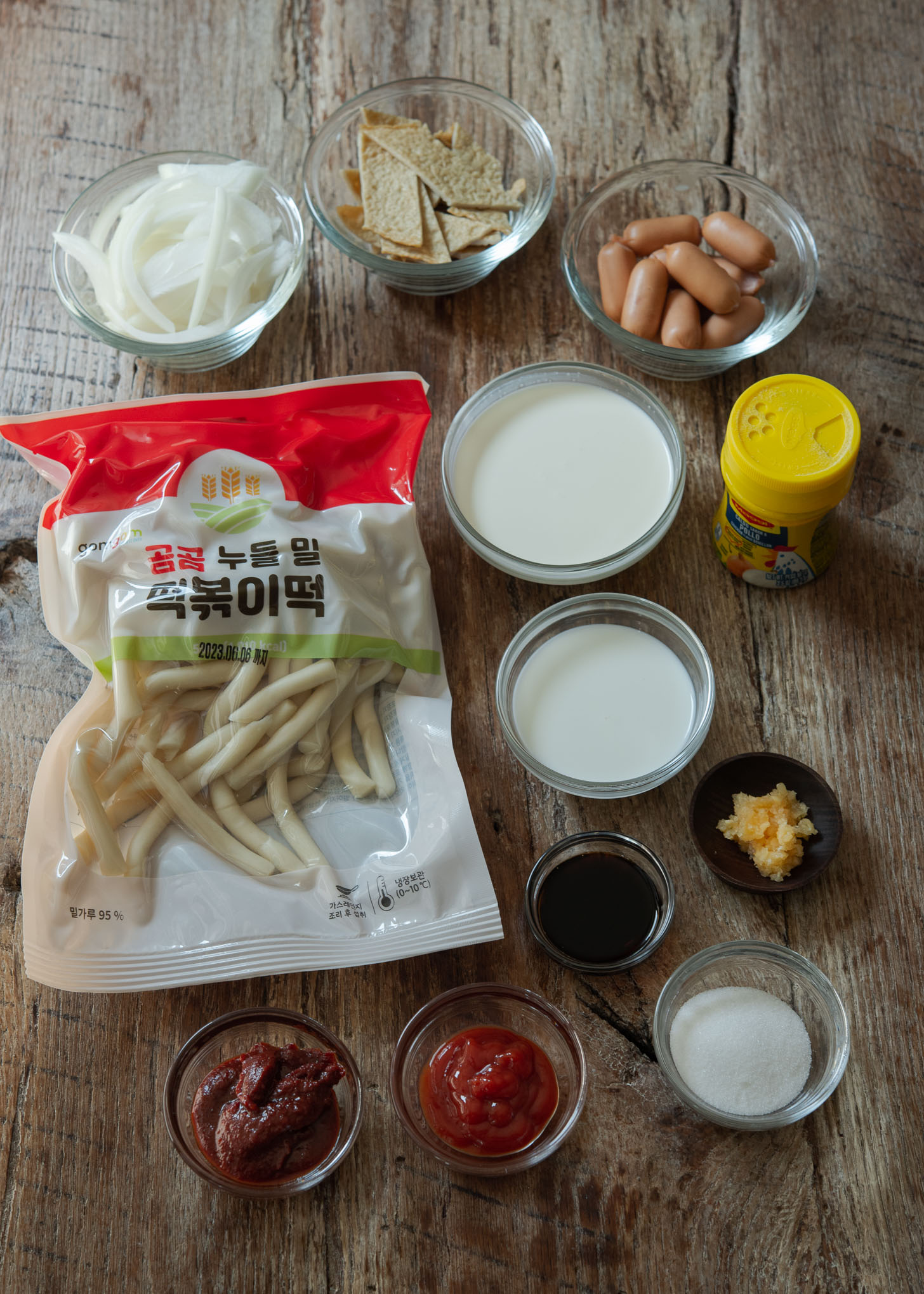
- Rice cakes (tteok or mil-tteok): Although “tteokbokki” literally means rice cakes, most Korean restaurants actually use mil-tteok (wheat cakes) for rose tteokbokki. They stay softer in the sauce and don’t get overly chewy, which makes them perfect for creamy versions like this. I usually go with mil-tteok since that’s what you’ll be served in Korea.
- Sausage: Cocktail sausages are common in Korea, but you don’t need to limit yourself. I sometimes use a smokier sausage, like kielbasa, for a richer, heartier flavor.
- Fish cake (optional): Thin, flat Korean fish cakes add a savory depth that’s typical of bunsik-style tteokbokki. If you’re not a fan, simply skip them—the dish will still be delicious.
- Cream + milk: The balance of heavy cream and milk is what makes this dish indulgent yet not too heavy. If you don’t usually stock both, half-and-half works well in a pinch.
- Gochujang: This is the backbone of the sauce. I recommend using a good Korean brand rather than generic supermarket versions—the depth and subtle smokiness really make a difference in flavor.
- Optional add-ins: Rose tteokbokki is easy to customize. I sometimes toss in cabbage, glass noodles, or even bacon for extra texture. In Korea, mozzarella or cheddar cheese is a popular topping, but I usually skip them and finish with a light sprinkle of parmesan—it keeps the cream and gochujang flavors in balance.
Step-by-Step: How to make Rose Tteokbokki
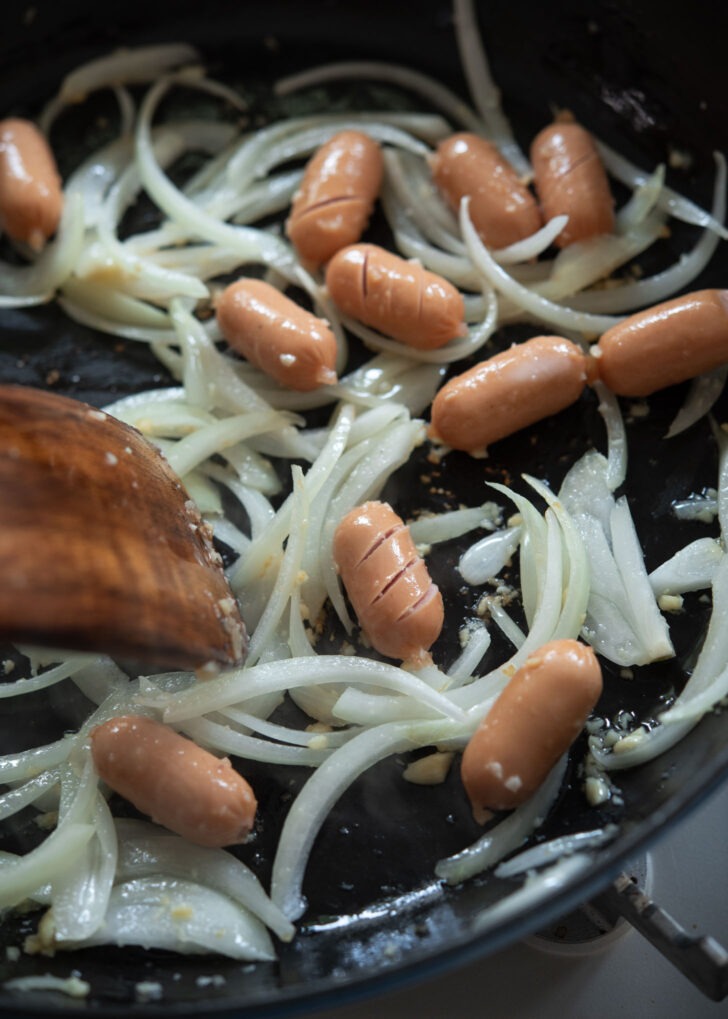
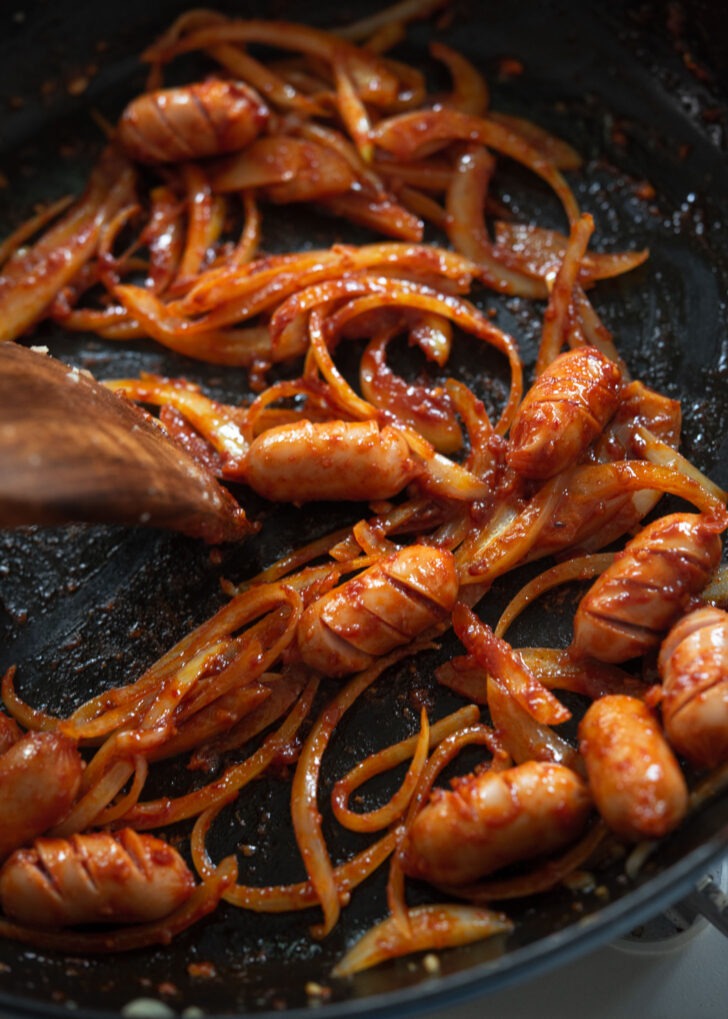
Sauté onion and garlic in a little oil until softened, then stir in sausage for extra depth. A quick toss with gochujang helps release its smoky spice.
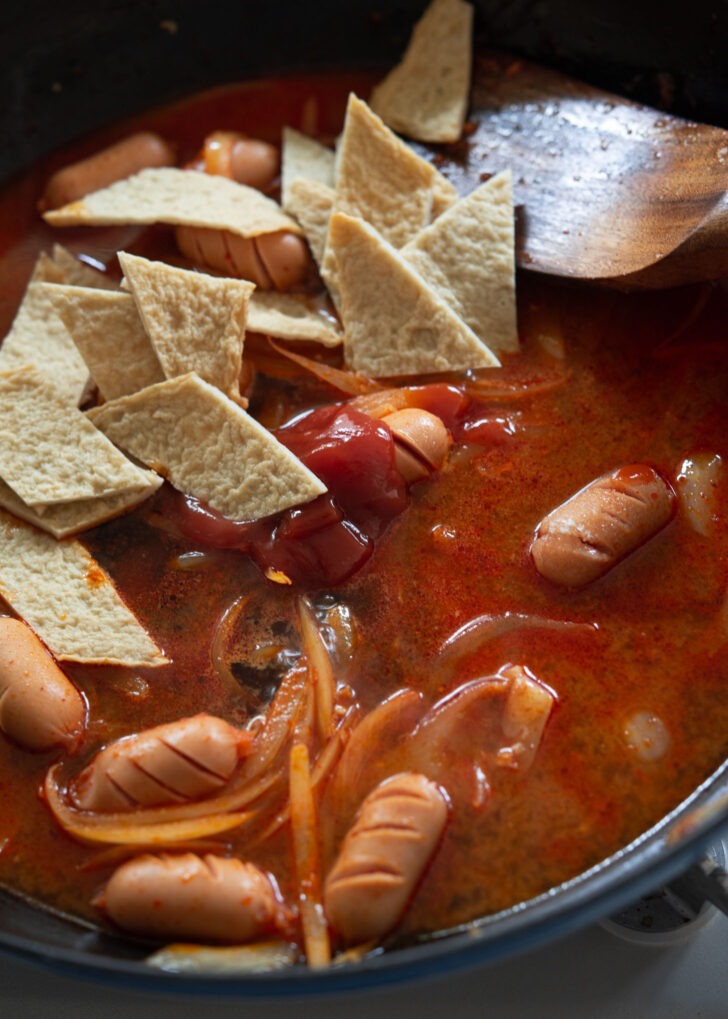
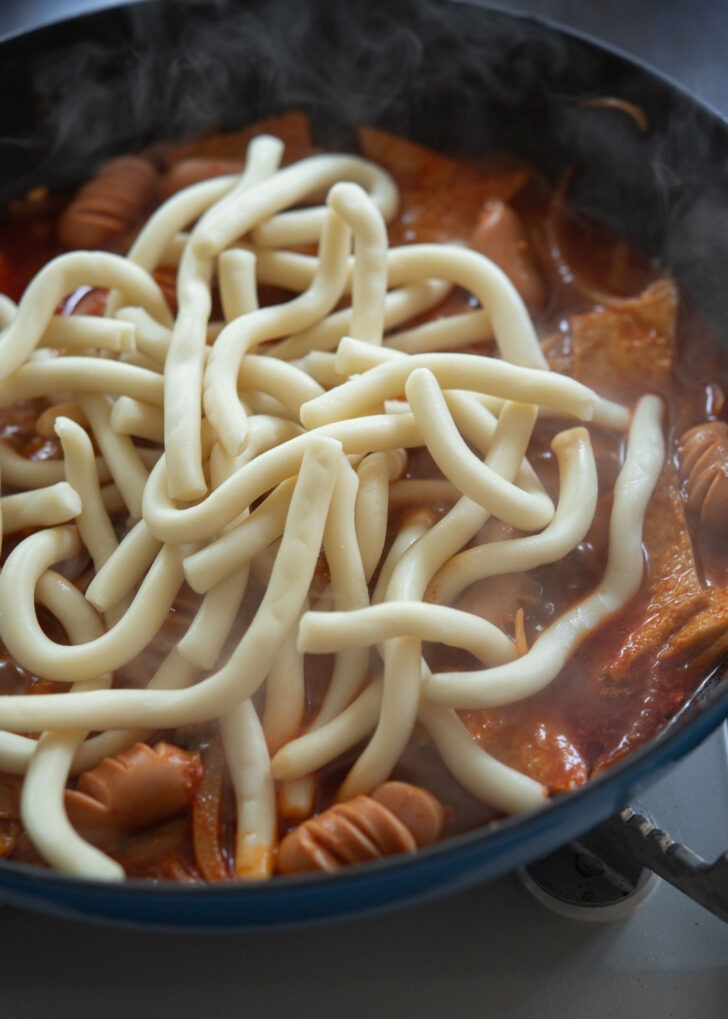
Add water, fish cake, ketchup, soy sauce, sugar, and a touch of chicken bouillon if using. Stir in the rice cakes and bring everything to a gentle boil.
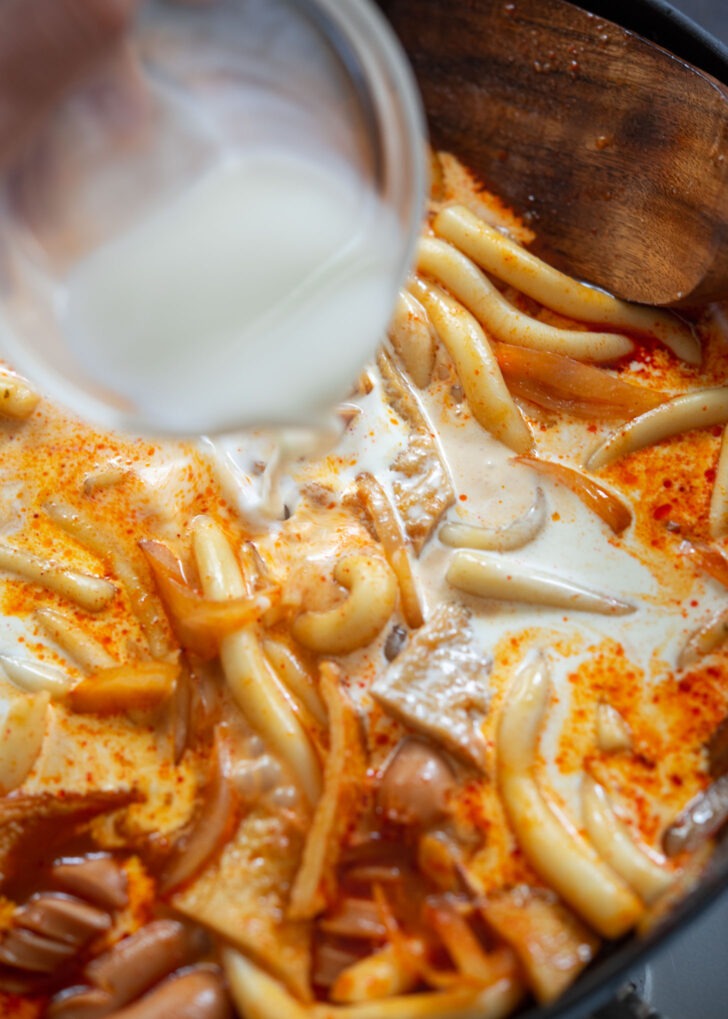
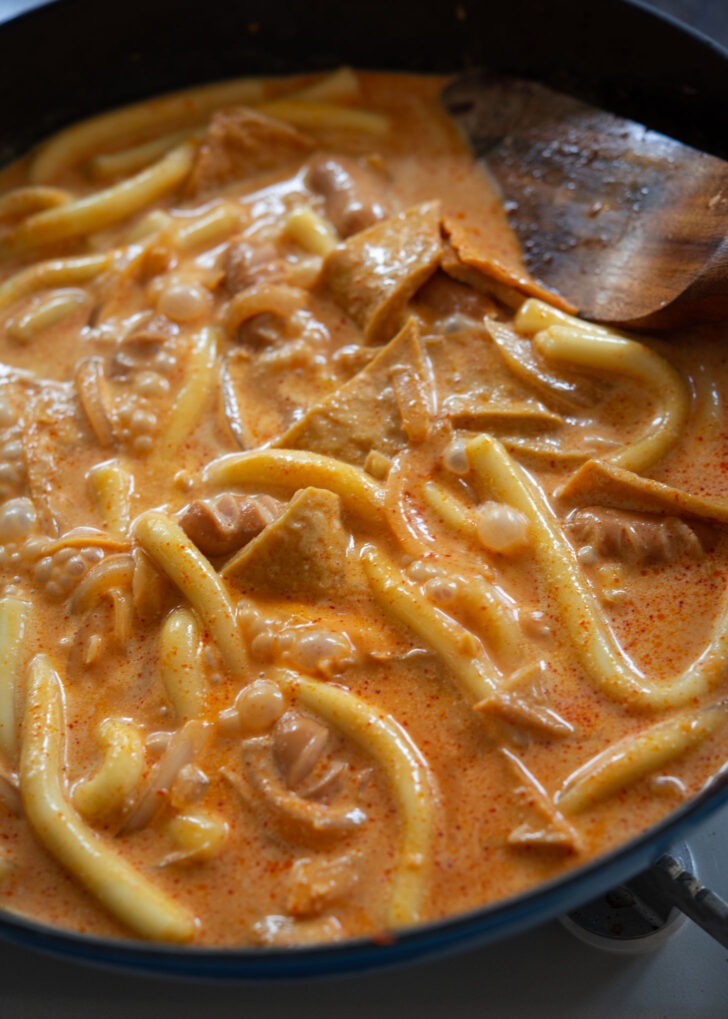
Pour in cream and milk, then finish with parmesan if you like it extra rich. Simmer until the rice cakes are tender and the sauce has thickened slightly.
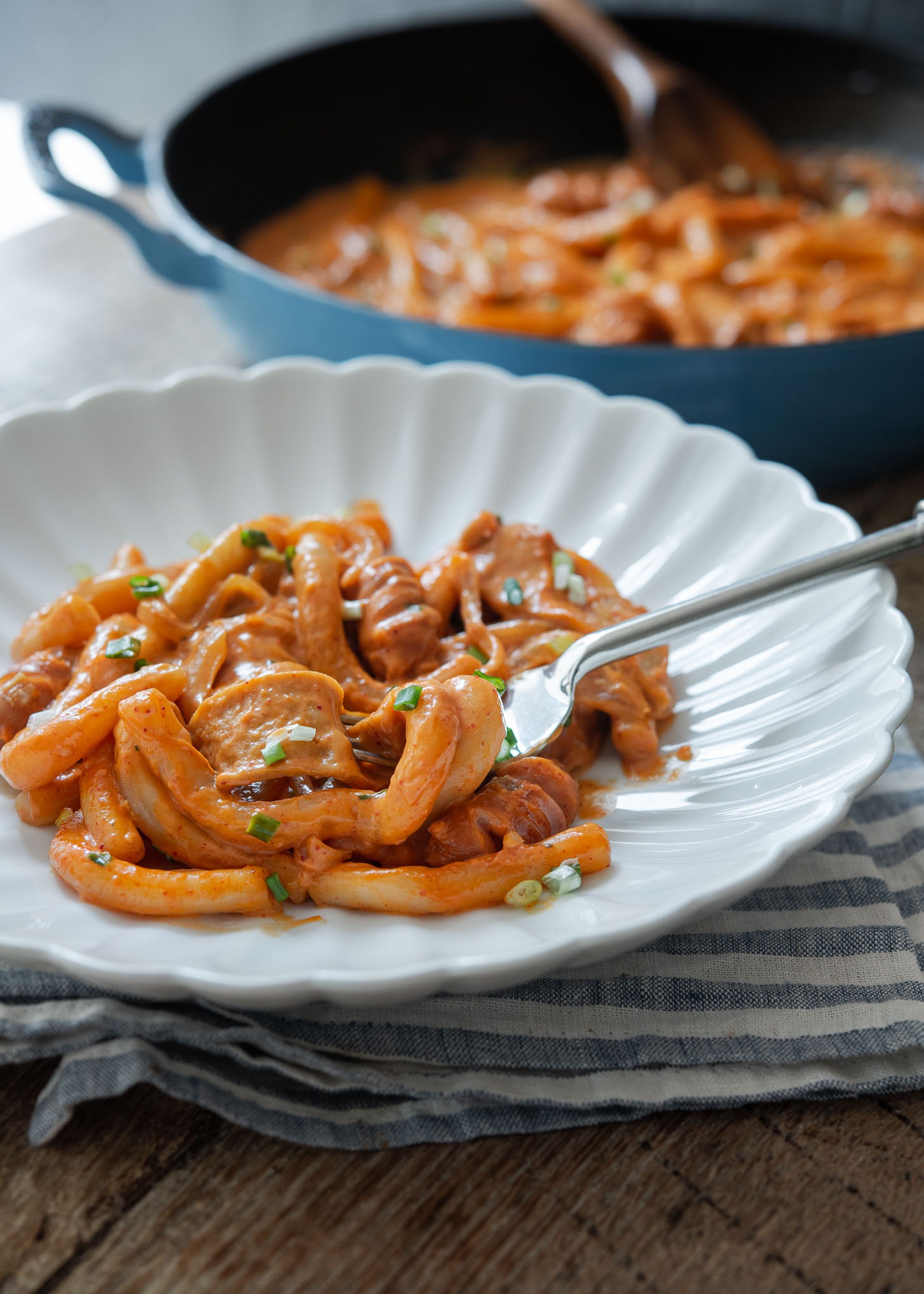
Serving and Reheating Suggestions
Rose tteokbokki is best enjoyed piping hot, when the rice cakes are soft and the sauce is at its creamiest. I often serve it alongside kimbap or crispy gimmari for the full Korean street food party at home —it feels like bringing a bunsik shop right to the table.
Leftovers don’t usually last long in my house, but if you do have some, keep them in the fridge for up to 4–5 days. When reheating, splash in a little milk to loosen the sauce and warm it gently on the stove. It brings back that silky texture without turning the rice cakes rubbery.
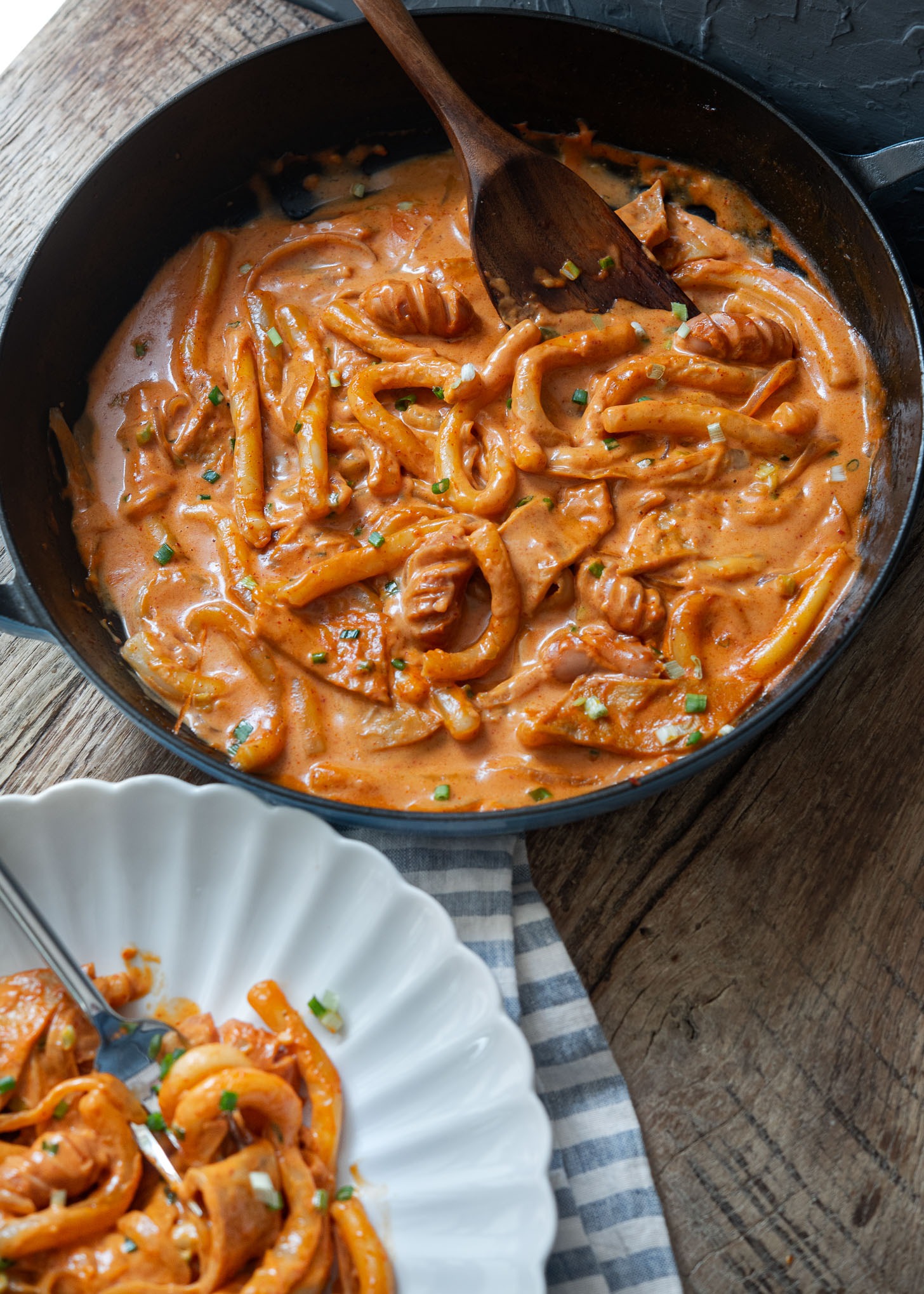
Love this recipe? Rate it and share your experience in the comments below! On Instagram? Tag me to showcase your creation. For more delicious recipes, subscribe to our newsletter!
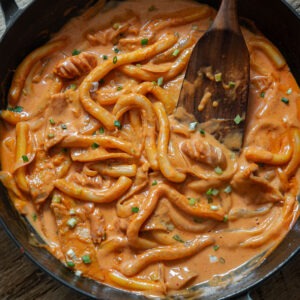
Rose Tteokbokki (Creamy Korean Rice Cakes)
Recipe Video
Ingredients
- 3/4 lb (320 g) Korean rice cakes for tteokbokki, or wheat cakes (mil-tteok)
- 1/2 small onion, thinly sliced
- 1/2 tbsp minced garlic
- 1/4 lb (113 g) cocktail sausage, roughly scored
- 2 sheets Korean fish cake, diced
- 4 tbsp (20 g) chopped green onion, to garnish, optional
For Creamy Rose Sauce
- 1 tbsp (15 ml) cooking oil
- 2 tbsp (30 g) Korean chili paste (gochujang)
- 1 cup (240 ml) water
- 1 tbsp (15 ml) ketchup
- 1 tbsp (15 ml) soy sauce
- 1 1/2 tbsp (20 g) sugar
- 1 tsp (4 g) chicken bouillon powder, optional
- 3/4 cup (160 ml) heavy cream, or whipping cream
- 1/4 cup (60 ml) milk
- 4 tbsp grated parmesan cheese, optional
Instructions
- Build the flavor base: Heat oil in a skillet over medium heat. Add onion and garlic and stir-fry until soft, about 2-3 minutes. Add sausage and continue to stir-fry for another 2 minutes.
- Create the sauce: Add gochujang and cook for another 1 minute. Pour in water and add fish cake, ketchup, soy sauce, sugar, and chicken bouillon powder (if using). Stir them well. Add the rice cakes (tteok) and bring the sauce to a gentle boil.
- Make it creamy: Add cream and milk, stirring everything well. Simmer for 4-5 minutes over medium-low heat until the rice cakes are tender and the sauce has thickened slightly. Add cheese, if using, to the sauce and stir well. Remove the skillet from the heat and garnish with green onion. Serve warm. The sauce will thicken more as it sits.
Notes
- While rice cakes are the most commonly used type of tteok in dishes like tteokbokki, there are other variations, such as mil-tteok (밀떡), which is made with wheat flour.
- Optional add-ins: Flat glass noodles, mandu, bacon, cheddar cheese, mozzarella cheese.

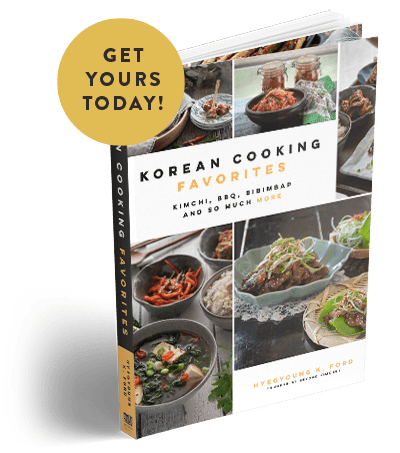
Very strange combo but it worked somehow.
This creamy milder version of tteokbokki looks so delicious and I’m sure my kids would love it!
Hi Michelle
Yes, it is a kid-friendly recipe. Hope you get to try it. Thanks for the comment.